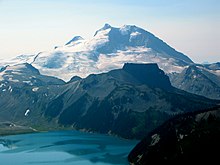Our website is made possible by displaying online advertisements to our visitors.
Please consider supporting us by disabling your ad blocker.
Volcanic field

A volcanic field is an area of Earth's crust that is prone to localized volcanic activity. The type and number of volcanoes required to be called a "field" is not well-defined.[1] Volcanic fields usually consist of clusters of up to 100 volcanoes such as cinder cones. Lava flows may also occur. They may occur as a monogenetic volcanic field or a polygenetic volcanic field.
- ^ Canon-Tapia, E (December 2017). "From 'Volcanic Field' to 'Volcanic Province': A Continuum of Spatial-Clustered Structures With Geological Significance or a Matter of Academic Snobbism?". American Geophysical Union, Fall Meeting 2017, Abstract #V54A-01. 2017. Bibcode:2017AGUFM.V54A..01C.
'Volcanic Field' is a term commonly used to describe a group of small, monogenetic and dominantly basaltic volcanoes, but that often includes groups of mixed monogenetic and polygenetic edifices. Besides ambiguities on the type of edifice that should be considered to form a VF, there is a lack of agreement concerning the number of volcanoes required to define a VF (ranging from five to over 1000), it is uncertain if the area covered by the volcanoes forming a VF must have a minimum number of volcanoes/unit area, or if the distance between adjacent structures needs to have a specific length. Furthermore, in many cases, it is uncertain whether some area is occupied by two adjacent fields or if it is occupied by two subgroups belonging to a unique field.
Previous Page Next Page


